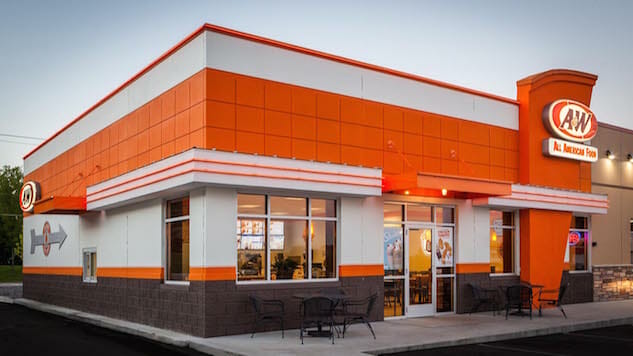When I moved from Canada to the U.S., there was no greater disappointment than when I first went to an A&W, naively assuming it would taste the same as the one I had grown up with in Canada.
After all, McDonald’s, Wendy’s and Burger King all do.
But the moment I bit into the burger, something seemed wrong. The patty was a lifeless salt lick, a disc of oil and burger essence trapped between overly-thick, mushy buns, like hospital pillows that one might use to quietly smother somebody.
I’m saying the burger was bad. Though the root beer was good.
And it wasn’t just that location. Thanks to the standardized system of fast food, I could find the same awful burger and mediocre onion rings at A&W locations across the country, most of them in the Midwest. Since I had already signed a lease and started a job, it was too late to move back to Canada. I cried for several days.
Back home, the Teen Burger is a revelation. Flavorful and juicy with a hint of peppercorn, it’s far superior to anything offered at any other chain, even looking a little like the picture. And whereas the U.S. onion rings feel like oily, spongy handcuffs, their Canadian brethren are crisp life preservers.
But the root beer’s the same.
Canadian and American A&Ws are fewer than 50 miles from each other across the border, and yet the distance in quality is even greater (cheap line). How did this travesty happen?
The “A” of A&W took form in 1919, when Roy Allen opened a simple root beer stand in Lodi, California. Much in the same way that you’ll sip your beverage while waiting for a burger, the public had to wait until 1923 for the burgers to show up at A&W’s first drive-in restaurant, which Allen opened with Frank Wright (he’s the W!). They soon began franchising all over the country and crossed the border in 1956 with restaurants in Montreal and Winnipeg. By the 70s, A&W had more locations than McDonald’s.
Clearly, some sort of ESPN 30 for 30 fall from grace is about to occur.
Most Canadians associate 1972 with the historic Summit Series between Canada and the USSR, but I’ll always think of it as the year A&W U.S. and Canada got divorced, when Unilever bought the Canadian franchises. It was a divorce that worked out better for Canada.
Today, there are more than 850 A&W franchises in Canada, easily outpacing Burger King and Wendy’s, and slowly inching closer to McDonald’s 1400 Canadian locations. The U.S. has a mere few hundred joints, many of which exist in humiliating A&W/KFC combos, where KFC is clearly the headliner.
The problem may begin with the menus. At Canadian A&Ws you’ll find a Baby Burger, Mama Burger, Papa Burger, Grandpa Burger, Uncle Burger and even a Buddy Burger, who stops by because he wishes he were part of the family, like Owen Wilson in The Royal Tenenbaums. The American menu is a broken, rudderless family, chaotically featuring a Papa Burger, Cheeseburger, Hamburger, Coney Dog and Chicken Strips. Where’s the foundation?
Similarly, U.S. A&W went through so many changes of ownership and identity that it lost track of its roots, resulting in franchise discontentment and inconsistent quality. After A. Alfred Taubman purchased the company in 1982, a freeze was placed on franchise development, and A&W dropped to fewer than 500 locations.
They tried a new upscale concept with a large salad bar and homemade ice cream. That didn’t work. They tried developing minimalist kiosks in malls called A&W Hot Dogs & More. Only a few are still operating.
To be fair, one of their failed concepts was not the company’s fault. In the early ‘80s, A&W introduced a Third Pounder to compete with McDonald’s Quarter Pounder, which featured a bigger third-pound of beef, performed better in taste tests, and was even less expensive. An aggressive campaign pushed the superior product, and Americans turned it down.
Taubman griped about the nationwide rejection in his book Threshold Resistance:
More than half of the participants in the Yankelovich focus groups questioned the price of our burger. “Why,” they asked, “should we pay the same amount for a third of a pound of meat as we do for a quarter-pound of meat at McDonald’s? You’re overcharging us.” Honestly. People thought a third of a pound was less than a quarter of a pound. After all, three is less than four!
Who knows where the company would be today, or even the country itself, had those Americans paid closer attention in math class? We could have at least avoided this article.
Make no mistake, I do want A&W to succeed. It’s an American icon, but the icon is being better sustained in Canada. I can only drive north so many times ostensibly to see friends or family when in reality I’m seeking only the warm embrace of a Teen Burger.
During my last trip to Vancouver, I sat in one with tears in eyes, reveling in the sandwich and
knowing how long it would be before I could return. When all seemed lost, a sliver of hope shone through the fog of my frosty root beer glass. On the counter sat a stand of little orange bottles filled with A&W burger seasoning, apparently housing everything Canada is in a slim cylinder.
“Are these for sale?” I asked the cashier.
“Of course,” he responded.
“Fools!” I yelled, laughing manically. “I’ll take 10.”
So I took something with me when I left, and stashed them under my car seat like a criminal before crossing the border. I kept nine of the bottles for myself so I can always smell Canada from my apartment in Seattle. The other I placed in a box and mailed to the U.S. A&W headquarters in Lexington, Kentucky.
That’s how you start a revolution.
